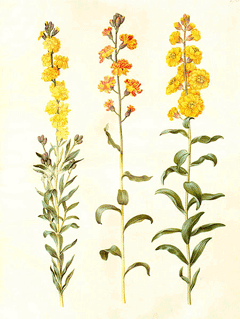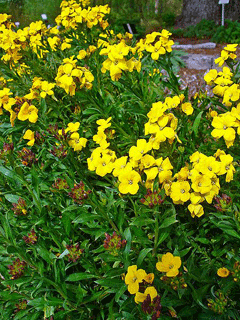 |
|
http://commons.wikimedia.org/wiki/File:Gc28_cheiranthus_cheirii.jpg |
 |
| http://commons.wikimedia.org/wiki/User:Llez |
Translate this page:
Summary
Physical Characteristics

 Erysimum cheiri is an evergreen Perennial growing to 0.5 m (1ft 8in).
Erysimum cheiri is an evergreen Perennial growing to 0.5 m (1ft 8in).
See above for USDA hardiness. It is hardy to UK zone 7 and is not frost tender. It is in flower from April to June. The species is hermaphrodite (has both male and female organs) and is pollinated by Bees, flies.
It is noted for attracting wildlife.
Suitable for: light (sandy), medium (loamy) and heavy (clay) soils, prefers well-drained soil and can grow in nutritionally poor soil. Suitable pH: neutral and basic (mildly alkaline) soils and can grow in very alkaline soils.
It cannot grow in the shade. It prefers dry or moist soil. The plant can tolerate maritime exposure.
UK Hardiness Map
US Hardiness Map
Synonyms
Cheiranthus cheiri. L.
Plant Habitats
Cultivated Beds; East Wall. In. South Wall. In. West Wall. In.
Edible Uses
References More on Edible Uses
Medicinal Uses
Plants For A Future can not take any responsibility for any adverse effects from the use of plants. Always seek advice from a professional before using a plant medicinally.
Antirheumatic Antispasmodic Aphrodisiac Cardiotonic Diuretic Emmenagogue Expectorant Nervine
Ophthalmic Purgative Resolvent Stomachic Tonic
Wallflower was formerly used mainly as a diuretic and emmenagogue but recent research has shown that it is more valuable for its effect on the heart[254]. In small doses it is a cardiotonic, supporting a failing heart in a similar manner to foxglove (Digitalis purpurea)[254]. In more than small doses, however, it is toxic and so is seldom used in herbal medicine[254]. The flowers and stems are antirheumatic, antispasmodic, cardiotonic, emmenagogue, nervine, purgative and resolvent[4, 7, 46, 61, 240]. They are used in the treatment of impotence and paralysis[240]. The essential oil is normally used[4]. This should be used with caution because large doses are toxic[7]. The plant contains the chemical compound cheiranthin which has a stronger cardiotonic action than digitalis (obtained from Digitalis species). If taken in large doses this is very poisonous and so this plant should not be used medicinally without expert supervision[244]. The seeds are aphrodisiac, diuretic, expectorant, stomachic and tonic[240]. They are used in the treatment of dry bronchitis, fevers and injuries to the eyes[240].
References More on Medicinal Uses
The Bookshop: Edible Plant Books
Our Latest books on Perennial Plants For Food Forests and Permaculture Gardens in paperback or digital formats.

Edible Tropical Plants
Food Forest Plants for Hotter Conditions: 250+ Plants For Tropical Food Forests & Permaculture Gardens.
More

Edible Temperate Plants
Plants for Your Food Forest: 500 Plants for Temperate Food Forests & Permaculture Gardens.
More

More Books
PFAF have eight books available in paperback and digital formats. Browse the shop for more information.
Shop Now
Other Uses
Essential
The flowers contain 0.06% essential oil[240]. It has a pleasing aroma if diluted and is used in perfumery[46, 61, 114, 244]. The seed contains about 20% fixed oil[240], but no details of any uses are given[K].
Special Uses
Attracts Wildlife Scented Plants
References More on Other Uses
Cultivation details
Prefers a position in full sun in a circumneutral soil[1, 111, 200]. Succeeds in ordinary garden soils[1], tolerating poor and limey soils[187]. Plants are liable to die out if the soil is too rich[111]. Wallflowers are perennial, though they are usually grown as biennials in the flower garden for spring and early summer bedding[1]. There are some named varieties[187]. A very ornamental plant[7], it is liable to die out after flowering, probably because it exhausts itself by producing so many flowers. Plants require a very well-drained dry soil if they are to survive a second winter[187]. They grow well on dry stone walls[201] and also on old mortared walls where they usually self-sow[219]. A good butterfly and moth plant[17, 30]. A good companion for apple trees[18, 20, 201].
References Carbon Farming Information and Carbon Sequestration Information
Temperature Converter
Type a value in the Celsius field to convert the value to Fahrenheit:
Fahrenheit:
The PFAF Bookshop
Plants For A Future have a number of books available in paperback and digital form. Book titles include Edible Plants, Edible Perennials, Edible Trees,Edible Shrubs, Woodland Gardening, and Temperate Food Forest Plants. Our new book is Food Forest Plants For Hotter Conditions (Tropical and Sub-Tropical).
Shop Now
Plant Propagation
Seed - sow spring in an outdoor seedbed. Germination should take place within 3 weeks. Plant the seedlings into their permanent positions when they are large enough to handle. If seed is in short supply, it can be sown in spring in pots in a cold frame. When they are large enough to handle, prick the seedlings out into individual pots and plant them out in early summer.
Other Names
If available other names are mentioned here
Native Range
Coming Soon
Weed Potential
Right plant wrong place. We are currently updating this section.
Please note that a plant may be invasive in one area but may not in your area so it's worth checking.
Conservation Status
IUCN Red List of Threatened Plants Status :

Growth: S = slow M = medium F = fast. Soil: L = light (sandy) M = medium H = heavy (clay). pH: A = acid N = neutral B = basic (alkaline). Shade: F = full shade S = semi-shade N = no shade. Moisture: D = dry M = Moist We = wet Wa = water.
Now available:
Food Forest Plants for Mediterranean Conditions
350+ Perennial Plants For Mediterranean and Drier Food Forests and Permaculture Gardens.
[Paperback and eBook]
This is the third in Plants For A Future's series of plant guides for food forests tailored to
specific climate zones. Following volumes on temperate and tropical ecosystems, this book focuses
on species suited to Mediterranean conditions—regions with hot, dry summers and cool, wet winters,
often facing the added challenge of climate change.
Read More
Expert comment
Author
(L.)Crantz.
Botanical References
200
Links / References
For a list of references used on this page please go here
Readers comment
| Add a comment |
|
If you have important information about this plant that may help other users please add a comment or link below. Only comments or links that are felt to be directly relevant to a plant will be included. If you think a comment/link or information contained on this page is inaccurate or misleading we would welcome your feedback at [email protected]. If you have questions about a plant please use the Forum on this website as we do not have the resources to answer questions ourselves.
* Please note: the comments by website users are not necessarily those held by PFAF and may give misleading or inaccurate information.
To leave a comment please Register or login here All comments need to be approved so will not appear immediately.
|
Subject : Erysimum cheiri
|
|
|
|